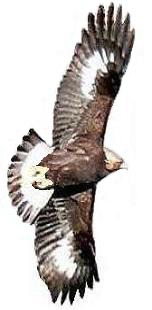(Accipiter gentilis)
Migration Timeframe:
Although the first few Goshawks
are spotted migrating in September, they really start
to move in early October. Their numbers
peak from mid to late October with migration continuing
through November. A few leave in December, and some as late
as January.
|
Year |
Peak Week |
Avg |
|
2002-2007 |
Oct 20-26 |
12 |
|
Year |
Peak Week |
Count |
|
2008 |
Oct 27-Nov 02 |
15 |
|
Year |
Earliest
Obs |
Count |
Year |
Latest
Obs |
Count |
|
2002-2007 |
Sep 03 2005 |
2 |
2002-2007 |
Dec 01 2007 |
2 |
|
2008 |
Oct 05 |
5 |
2008 |
Nov 21 |
1 |
Where to Watch:
Like the other accipiters, the Goshawks
tend to sneak past the hawkwatch
along the tree lines. Their flight level is often lower compared to most of the other
raptors although they can be seen soaring and kettling. The best views of
Goshawks are usually right at "Sharpie Alley" (just south
of the ravine) much like the Sharpies and Cooper's. They may also be
see farther north (past the
intersection at Dexter Line) and even along the large ridge at Fruit
Ridge Rd.
High Counts:
There were no new records set for Goshawks in 2008.
|
1-Year |
Count |
1-Month |
Count |
|
2004 |
68 |
Nov 2004 |
46 |
|
1-Day |
Count |
1-Hour |
Count |
|
Oct 11 1996 |
20 |
Oct 11 2007 |
5 |
Yearly Totals:
The 2008 yearly total for Northern Goshawks was barely half of the
10-Year average and well short of the 5-Year average. (averages are based on 1998-2007 and
2003-2007 counts).
|
Year |
Count |
Year |
Count |
Year |
Count |
|
1995 |
30 |
2000 |
17 |
2005 |
66 |
|
1996 |
35 |
2001 |
43 |
2006 |
52 |
|
1997 |
46 |
2002 |
19 |
2007 |
34 |
|
1998 |
7 |
2003 |
52 |
2008 |
23 |
|
1999 |
22 |
2004 |
68 |
2009 |
N/A |
Interesting Facts:
-
Goshawks have a very large white eyebrow stripe that is
often visible even in flight.
-
When soaring, their tail exhibits a wedge shape.
-
Goshawks
are sexually dimorphic (though the least so of our
accipiters) with marginal or no overlap.
-
Males are smaller than females but
not always separable in the field.
-
Males have slightly finer barring on their undersides (body
and wings) than females.
-
Adults may stay in or close to breeding territories except
when prey is scarce (Snowshoe Hares and Ruffed Grouse).
-
In Ontario, adults usually winter in northern forests if prey
is abundant. Juveniles usually depart natal regions.
Goshawks will migrate in any direction to wooden tracts of
any age, wooded rural and urban locales, and sometimes to
areas with marginal tree growth.
-
Southward movements are seldom to southern parts of the U.S.,
i.e. rarely seen in Florida
